静态动词与动态动词
静态动词与动态动词

• 静态动词用于进行体时,则成了动态动词, 意义有所不同: He’s being polite today. • They were having a party. • He is resembling his father. • The chef is tasting the soup. • Please be quiet. I’m thinking. • I’m hoping you can make an exception to the children.
• 静态动词: • 表示一种状态,通常用于非进行体;若用进行体, 语义不同. • 1. be, have • 2. 含有be和have 意义的词,如 apply to, belong to, differ from, cost, weight, measure, fit, hold, lack, resemble • 3. 表示感觉的动词:feel, hear, see, smell, taste • 4. 表心理或情感状态的动词:believe, assume, consider, detest, fear, know, like, love, mean, mind, notice, prefer, remember
动词的时、体、态
• • • • • • 1. 两种时间:现在和过去 2.两种体:进行体和完成体 3. 结合: 现在:一般,进行,完成,完成进行 过去:一般,进行,完成,完成进行 4. 语态:主动和被动; be型被动态和get型 被动态
一般现在时
• 1. 表示不受时限的客观存在(真理、格言、科学 事实等) • 2. 表示习惯性经常性的动作 • 3. 表示现时的状态和现在瞬间动作:What’s the matter with you? You look pale. / What do you think? • 常用于体育的现场报道、戏法表演、操作演示的 解说词中(见教材) • 也用于一些习惯性的用法中:I declare the conference open. / I wish you all the best.
动态和静态动词
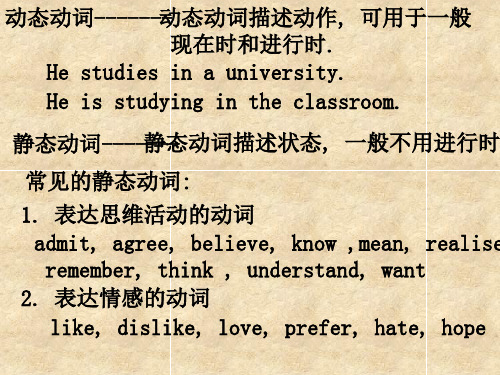
He studies in a university. He is studying in the classroom.
静态动词----静--态- 动词描述状态, 一般不用进行时
常见的静态动词:
1. 表达思维活动的动词 admit, agree, believe, know ,mean, realise remember, think , understand, want
He is tasting the soup.
闻起来有…味 + adj. smell
闻 The meat smells good.
The room smells damp.
They can smell the gas.
He is smelling the meat.
看起来…. look 看
+ adj.
有 have
吃, 开, 喝…
We have a second-hand car. She is having some tea. ( drink )
They are having a sports meeting.
认为 think
想/ 考虑/思考 I think it’s a great idea. Do you think they will come? I’m thinking about my exam.
What are you thinking ? 感觉到/ 摸起来 + adj.
feel 觉得/ 感到
I feel tired.
They feel they need more tome. ( 认为 )
静态和动态动词
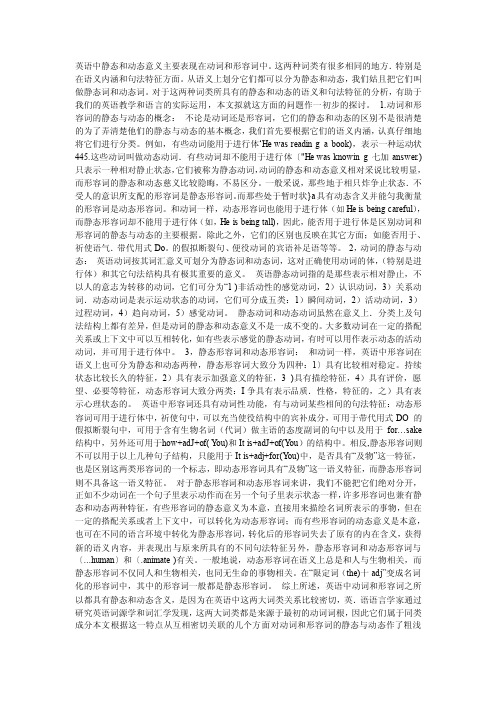
英语中静态和动态意义主要表现在动词和形容词中。
这两种词类有很多相同的地方.特别是在语义内涵和句法特征方面。
从语义上划分它们都可以分为静态和动态,我们姑且把它们叫做静态词和动态词。
对于这两种词类所具有的静态和动态的语义和句法特征的分析,有助于我们的英语教学和语言的实际运用,本文拟就这方面的问题作一初步的探讨。
1.动词和形容词的静态与动态的概念:不论是动词还是形容词,它们的静态和动态的区别不是很清楚的为了弄清楚他们的静态与动态的基本概念,我们首先要根据它们的语义内涵,认真仔细地将它们进行分类。
例如,有些动词能用于进行体…Hewasreading a book),表示一种运动状445.这些动词叫做动态动词.有些动词却不能用于进行体〔"He was knowing七加answ er.)只表示一种相对静止状态,它们被称为静态动词,动词的静态和动态意义相对采说比较明显,而形容词的静态和动态慈义比较隐晦,不易区分。
一般采说,那些地于相只炸争止状态.不受人的意识所支配的形容词是静态形容词。
而那些处于暂时状}a具有动态含义并能匀我衡量的形容词是动态形容词。
和动词一样,动态形容词也能用于进行体(如He is being careful),而静态形容词却不能用于进行体(如,He is being tall),因此,能否用于进行体是区别动词和形容词的静态与动态的主要根据。
除此之外,它们的区别也反映在其它方面;如能否用于、祈使语气.带代用式Do。
的假拟断裂句、便役动词的宾语补足语等等。
2,动词的静态与动态:英语动词按其词汇意义可划分为静态词和动态词,这对正确使用动词的体,(特别是进行体)和其它句法结构具有极其重要的意义。
英语静态动词指的是那些表示相对静止,不以人的意志为转移的动词,它们可分为“1)非活动性的感觉动词,2)认识动词,3)关系动词.动态动词是表示运动状态的动词,它们可分成五类:1)瞬间动词,2)活动动词,3)过程动词,4)趋向动词,5)感觉动词。
静态动词与动态动词
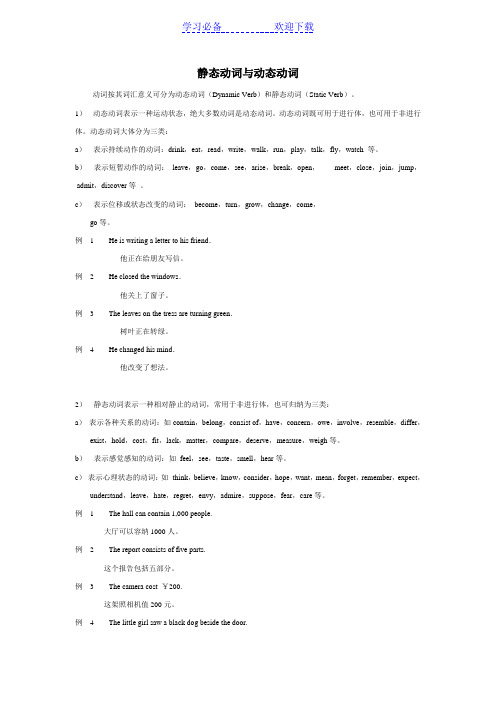
静态动词与动态动词动词按其词汇意义可分为动态动词(Dynamic Verb)和静态动词(Static Verb)。
1)动态动词表示一种运动状态,绝大多数动词是动态动词。
动态动词既可用于进行体,也可用于非进行体。
动态动词大体分为三类:a)表示持续动作的动词:drink,eat,read,write,walk,run,play,talk,fly,watch 等。
b)表示短暂动作的动词:leave,go,come,see,arise,break,open,meet,close,join,jump,admit,discover等。
c)表示位移或状态改变的动词:become,turn,grow,change,come,go等。
例 1 He is writing a letter to his friend.他正在给朋友写信。
例 2 He closed the windows.他关上了窗子。
例 3 The leaves on the tress are turning green.树叶正在转绿。
例 4 He changed his mind.他改变了想法。
2)静态动词表示一种相对静止的动词,常用于非进行体,也可归纳为三类:a)表示各种关系的动词:如contain,belong,consist of,have,concern,owe,involve,resemble,differ,exist,hold,cost,fit,lack,matter,compare,deserve,measure,weigh等。
b)表示感觉感知的动词:如feel,see,taste,smell,hear等。
c)表示心理状态的动词:如think,believe,know,consider,hope,want,mean,forget,remember,expect,understand,leave,hate,regret,envy,admire,suppose,fear,care等。
关于英语动态动词语静态动词的用法(吉林)

关于英语动态动词与静态动词的用法李丽华(鞍山师范学院外语系鞍山114005)摘要:本文从英语动态动词和静态动词的分类入手,根据分析和比较的结果,系统地阐述动态动词和静态动词的用法。
关键词:动态动词静态动词Abstract: This thesis elaborates the usage of the English dynamic and stative verbs systematically and focusses the attention on the accurate use of various verbs in the Englishlanguage.Key Wrds: Dynamic verbs Stative verbs英语中的动态动作和静态状态可以表现在动词中,从语义角度讲,动词可以分为动态和静态。
本文着重就动态动词(dynamic verbs)和静态动词(stative verbs)的语义和句法特征做进一步的分析。
一、动词(dynamic verbs)和静态动词(stative verbs)的概念及分类。
实义动词按其语义特征可以分为动态动词和静态动词。
1.动态动词(dynamic verbs):表示运动状态的动词。
这类动词分为五种:(1)活动动词(activity verbs)(2)过程动词(process verbs)(3)感觉动词(verbs of bodily sensation)(4)过渡性动词(transitional verbs)(5)瞬间动词(momentary verbs)2.静态动词(stative verbs):表示相对静止状态的动词。
这类动词分为三种:(1)感觉动词(verbs of perception)(2)认识动词(verbs of cogition)(3)关系动词(relation verbs)二、动态动词(dynamic verbs)1.活动动词(activity verbs):这类动词表示动作的发出者的有意识的,主动的行为。
Grammar动态动词与静态动词的区别

Grammar Workshop Dynamic vs. State VerbsDynamic VerbsDynamic verbs describe activities, events and actions that can begin and finish. Dynamic verbs can be used in continuous tenses.The dynamic Verbs are divided into:activity verbsprocess verbstransitional events verbsmomentary verbsActivity Verbsare verbs that can be used in either continuous or simple tense without any change in meaning For example: They will be studying this afternoon. Vs. They will play this afternoon.(There is no change in meaning.)Here is a list some activity verbs:abandon askbegcall drink eathelplearnlistenlook atplayrainreadsayslicethrowwhisperworkwriteProcess Verbsare verbs that describe a process. These verbs can be used in either continuous or simple tense without any change in meaning.For example: With age people slow down. Vs. With age people are slowing down.Here is a list some activity verbs:change deteriorate growmatureslow down widenTransitional Events Verbsare verbs that differentiate between the beginning of an event or one complete action. Continuousforms indicate the beginning of an event while the simple forms describe a repetitive event or one single action.For example: She was leaving (when I came in). Vs. She left.arrive die falllandleave loseMomentary Verbsare verbs that show a short duration or a repetition. They are used in the continuous forms. For example: She is kicking the table. Vs. He has been nodding in agreement.hit jump kickknocknod tapState/stative VerbsRefer to a state or condition that is static or unchanging. These verbs cannot be normally used with continuous tenses. Some of them, however, can be used with continuous tenses with a change in meaning. Stative Verbs are generally divided into three categoriesrelational verbsperception verbscognition categoriesRelational verbs are verbs that almost never form continuous forms.We say: It belongs to me. not It is belonging to me. or I deserve. not I am deserving it.Here is a list of relational verbs:belong to concern consist of contain cost depend ondeserveequalfithaveincludeinvolvelackmatterneedoweownpossessrequirerequireresembleseemsoundPerception Verbs are verbs that can form a continuous form but with the change in the regular meaning.Here is a list and a detailed description of the perception verbs:smell taste see hearsmellShe is smelling the roses. - The continuous form expresses a voluntary action.They smell wonderful. - The simple form expresses an involuntary action something that just happened and cannot be controlled.tasteShe is tasting the soup. - The continuous form expresses a voluntary action.It tastes great. - The simple form expresses an involuntary action something that justhappened and cannot be controlled.seeExample Form MeaningI see.Simple Present I understand.I see him now. Present Continuous I see him with my eyes.I am seeing images.Present Continuous Mental illnessI am seeing my dentist tonight.Present Continuous AppointmentShe has been seeing him forPresent Continuous Datingthree months.hearI hear you now.(You don't need to shout.) - The simple form means I hear you with myears. (I'm perceiving).I am hearing some voices. - The continuous form means a mental illness.Cognition Verbs are verbs that may not form a continuous tense at all or when they are used in a continuous form their regular meaning changes.Cognition Verbs that hardly ever form a continuous form:abhor adore astonish believe desire detest dislike doubt forgive hateimagineimpressintendknowlikelovemeanmindperceivepleasepreferpresupposerealizerecallrecognizeregardsatisfysupposeunderstandHere is a list of cognition verbs that form a continuous form with a change in meaning:feel think wish havefeelExample Form MeaningI am not feeling well.Continuous Healthy/unhealthyI feel good.Simple Expresses a mood.I am feeling the fabric.Continuous Touching/voluntary actionIt feels soft.Simple Involuntary actionthinkExample Form MeaningI think it’s a good idea.Simple OpinionI am thinking about the exam.Continuous Mental ProcesswishExample Form MeaningI wish I ha a car.Simple A wishI am wishing for a new car.Continuous Present imaginationhaveExample Form MeaningI have a car.Simple PossessionI am having a good time.Continuous Not a possession。
动态性动词和静态性动词

动态性动词和静态性动词动态性动词与静态性动词(1)Dynamic Verb and Static Verb英语动词按其是否可以用于进行时态的语义特征,可以分为动态性动词和静态性动词。
大量的动词是动态性的,可以用于进行时态。
有一些动词是静态性的,不能用于进行时态。
还有不少动词,兼有动态与静态两种特性,而其含义是不同的。
动态性动词与静态性动词的用法有四个不同之处:(1)动态性动词可用于进行时态,而静态性动词则不可。
这是两种动词最根本的区别,例如:1)John is writing to his father.(约翰正在给他的父亲写信。
)2)John resembles his father.(约翰长得像他的父亲。
)John is resembling his father.(Impossible)3)John is painting his house.(约翰正在油漆他的房子。
)4)John owns a house.(约翰拥有一所房子。
)John is owning a house.(Impossible)有些动词可兼作两类动词,但意思不同。
动词“hold”的句子主语是人,则作“握住”解,是个动态性动同;句子主语是处所,则作“容纳”解,是个静态性动词,例如:5)a.John is holding a ball in his hands.b.John has a ball in his hands.(约翰正用两手握住球。
)6)a.The bus holds 50 people.b.50 people can sit in the bus.(这辆公共汽车能坐五十人。
)动词have可兼作两种类型。
当作动态性动词用时,表示动作的发生或过程,相当于take,get,receive,eat,drink等词,可用于进行时态。
当作静态性动词用时,表示“拥有”的概念,相当于own,possess等词,没有进行时态,例如:7)a.I was having my coffee quietly.b.I was drinking my coffee quietly.(当时我正在默默地喝咖啡。
动态动词与静态动词
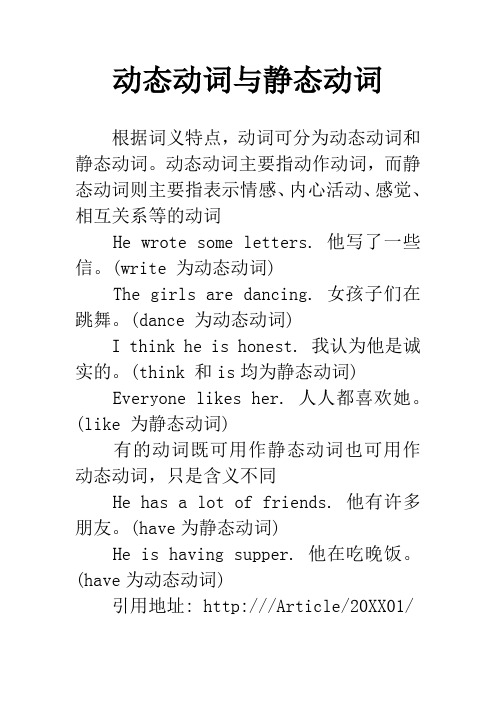
动态动词与静态动词
根据词义特点,动词可分为动态动词和静态动词。
动态动词主要指动作动词,而静态动词则主要指表示情感、内心活动、感觉、相互关系等的动词
He wrote some letters. 他写了一些信。
(write 为动态动词)
The girls are dancing. 女孩子们在跳舞。
(dance 为动态动词)
I think he is honest. 我认为他是诚实的。
(think 和is均为静态动词)
Everyone likes her. 人人都喜欢她。
(like 为静态动词)
有的动词既可用作静态动词也可用作动态动词,只是含义不同
He has a lot of friends. 他有许多朋友。
(have为静态动词)
He is having supper. 他在吃晚饭。
(have为动态动词)
引用地址: http:///Article/20XX01/。
动词分类
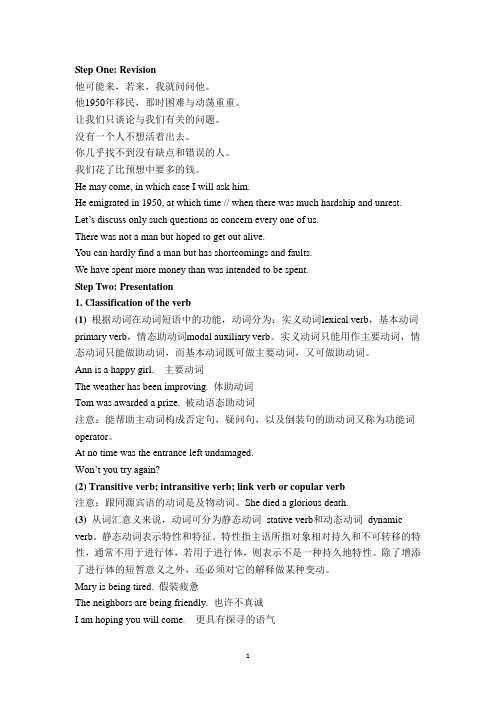
Step One: Revision他可能来,若来,我就问问他。
他1950年移民,那时困难与动荡重重。
让我们只谈论与我们有关的问题。
没有一个人不想活着出去。
你几乎找不到没有缺点和错误的人。
我们花了比预想中要多的钱。
He may come, in which case I will ask him.He emigrated in 1950, at which time // when there was much hardship and unrest. Let’s discuss only such questions as concern every one of us.There was not a man but hoped to get out alive.You can hardly find a man but has shortcomings and faults.We have spent more money than was intended to be spent.Step Two: Presentation1. Classification of the verb(1) 根据动词在动词短语中的功能,动词分为:实义动词lexical verb,基本动词primary verb,情态助动词modal auxiliary verb。
实义动词只能用作主要动词,情态动词只能做助动词,而基本动词既可做主要动词,又可做助动词。
Ann is a happy girl. 主要动词The weather has been improving. 体助动词Tom was awarded a prize. 被动语态助动词注意:能帮助主动词构成否定句,疑问句,以及倒装句的助动词又称为功能词operator。
At no time was the entrance left undamaged.Won’t you try again?(2) Transitive verb; intransitive verb; link verb or copular verb注意:跟同源宾语的动词是及物动词。
商务英语笔记(一)

商务英语笔记(一)商务英语笔记第一部分:商务英语概述1.什么是商务英语?–商务英语是一种使用英语进行商业交流的方式。
2.商务英语的重要性–在全球化的今天,商务交流已成为跨国企业合作的必备条件,而英语则成为了国际商务交流的主要语言。
第二部分:商务英语的语法要点1.静态动词和动态动词–在商务英语中,静态动词用于描述状态,动态动词则用于描述动作。
例如:The shipment contains 50 boxes ofgoods.(静态动词)We ship our products to over 50countries.(动态动词)2.不定式–商务英语中的不定式常用于表示目的、结果等。
例如:We signed the contract to achieve our common goals.第三部分:商务英语的常用词汇和表达方式1.商业词汇–汇票:draft–账单:invoice–订单:order2.商务常用表达–感谢来信:Thank you for your letter/email.–我们收到了你方的订单:We have received your order.–请尽快确认这份合同:Please confirm this contract as soon as possible.第四部分:商务英语的写作技巧1.清晰简洁–商务英语中的文章需要简洁明了,语言简单易懂,避免使用过于复杂的词汇和句式。
2.遵循礼仪原则–商务英语需要注意礼仪原则,例如在信件中要使用适当的称呼和结束语,尊重对方的文化背景。
结语商务英语在国际贸易中扮演着重要的角色。
通过学习商务英语的语法要点、常用词汇和表达方式以及写作技巧,我们可以更好地进行商业交流,促进商业合作的发展。
第五部分:商务英语的听说技巧1.提高听力水平–商务英语中常用的词汇和表达方式需要通过大量的听力练习来掌握。
可以通过听商业节目、观看商业视频等方式提高听力水平。
2.提高口语水平–在商务英语中,口语表达显得尤为重要。
英语专四语法术语(中英对照)

英语专四语法术语名词:noun个体名词:individual noun集体名词: collective noun 物质名词:material noun 抽象名词: abstract noun 可数名词:countable noun不可数名词:uncountable noun动词:verb动态动词:dynamic verb 静态动词:stative verb 情态动词:modal verb 助动词:auxiliary非谓语动词:non-finite verbs(分词,participle; 不定式, infinitive; 动名词,gerund)数词:numeral代词:pronoun人称代词:personal pronoun物主代词:possessive pronoun反身代词:reflexive pronoun指示代词:demonstrative pronoun 关系代词:relativepronoun不定代词:indefinitepronoun形容词:adjective副词:adverb冠词:article连词:conjunction介词:preposition感叹词:interjection限定词:determiner短语:phrase不定式短语:infinitivephrase动名词短语:gerundialphrase分词短语:participialphrase主语:subject谓语:predicate主谓一致:subject-verbagreement宾语:object补语:complement定语:attribute状语:adverbial同位语:appositive主语从句:subject clause表语从句:predicativeclause宾语从句:object clause定语从句:attributiveclause先行词:antecedent限制性定语从句:restrictive attributiveclause非限制性定语从句:non-restrictiveattributive clause状语从句:adverbialclause陈述句:Declarativesentence疑问句:interrogativesentence祈使句:imperativesentence感叹句:exclamatorysentence时态(各种时态) tense语态:voice主动语态:active voice被动语态:passive voice虚拟语气:subjunctivemood反义疑问句:tag question倒装:inversion部分倒装:partialinversion省略:ellipsis。
终结性动词、非终结性动词、持续性非终结性动词等名词解释
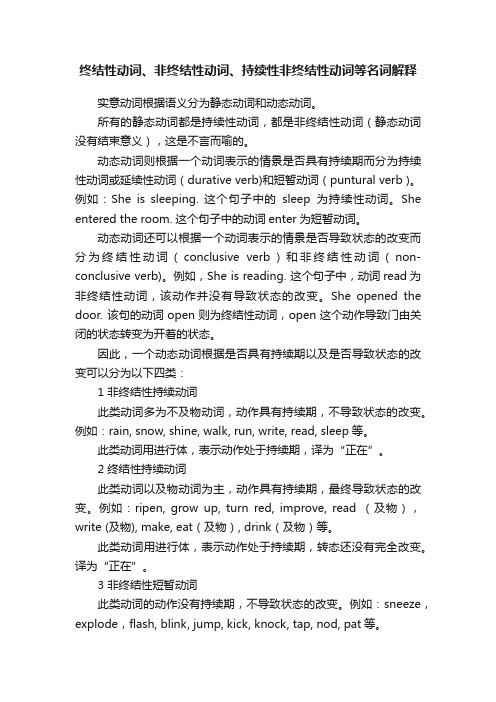
终结性动词、非终结性动词、持续性非终结性动词等名词解释实意动词根据语义分为静态动词和动态动词。
所有的静态动词都是持续性动词,都是非终结性动词(静态动词没有结束意义),这是不言而喻的。
动态动词则根据一个动词表示的情景是否具有持续期而分为持续性动词或延续性动词(durative verb)和短暂动词(puntural verb )。
例如:She is sleeping. 这个句子中的sleep为持续性动词。
She entered the room. 这个句子中的动词enter为短暂动词。
动态动词还可以根据一个动词表示的情景是否导致状态的改变而分为终结性动词(conclusive verb)和非终结性动词(non-conclusive verb)。
例如,She is reading. 这个句子中,动词read为非终结性动词,该动作并没有导致状态的改变。
She opened the door. 该句的动词open则为终结性动词,open这个动作导致门由关闭的状态转变为开着的状态。
因此,一个动态动词根据是否具有持续期以及是否导致状态的改变可以分为以下四类:1 非终结性持续动词此类动词多为不及物动词,动作具有持续期,不导致状态的改变。
例如:rain, snow, shine, walk, run, write, read, sleep等。
此类动词用进行体,表示动作处于持续期,译为“正在”。
2 终结性持续动词此类动词以及物动词为主,动作具有持续期,最终导致状态的改变。
例如:ripen, grow up, turn red, improve, read (及物),write (及物), make, eat(及物), drink(及物)等。
此类动词用进行体,表示动作处于持续期,转态还没有完全改变。
译为“正在”。
3 非终结性短暂动词此类动词的动作没有持续期,不导致状态的改变。
例如:sneeze,explode,flash, blink, jump, kick, knock, tap, nod, pat等。
静态动词和动态动词区别(12月20日)
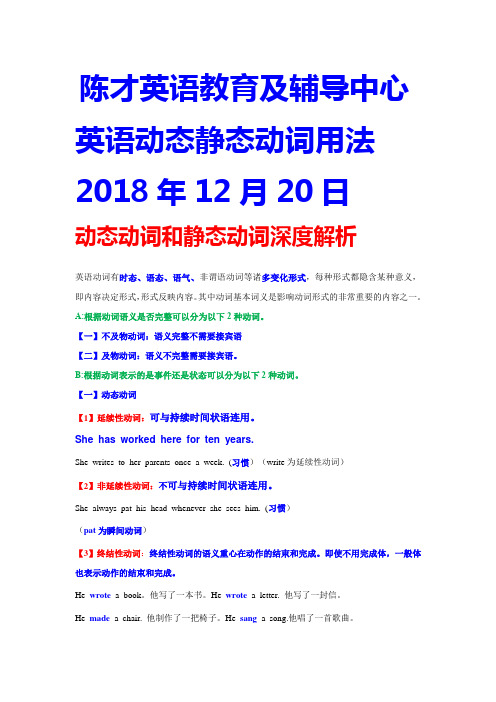
陈才英语教育及辅导中心英语动态静态动词用法2018年12月20日动态动词和静态动词深度解析英语动词有时态、语态、语气、非谓语动词等诸多变化形式,每种形式都隐含某种意义,即内容决定形式,形式反映内容。
其中动词基本词义是影响动词形式的非常重要的内容之一。
A:根据动词语义是否完整可以分为以下2种动词。
【一】不及物动词:语义完整不需要接宾语【二】及物动词:语义不完整需要接宾语。
B:根据动词表示的是事件还是状态可以分为以下2种动词。
【一】动态动词【1】延续性动词:可与持续时间状语连用。
She has worked here for ten years.She writes to her parents once a week. (习惯)(write为延续性动词)【2】非延续性动词:不可与持续时间状语连用。
She always pat his head whenever she sees him. (习惯)(pat为瞬间动词)【3】终结性动词:终结性动词的语义重心在动作的结束和完成。
即使不用完成体,一般体也表示动作的结束和完成。
He wrote a book。
他写了一本书。
He wrote a letter. 他写了一封信。
He made a chair. 他制作了一把椅子。
He sang a song.他唱了一首歌曲。
备注:终结性动词的动作如果没有结束,则需要使用进行体:He was writing a letter. 他在写一封信。
He was making a chair.他在制作一把椅子。
【4】非终结性动词:表示非终结动词没有终结意义动词。
He wrote for two hours.他写了4小说。
He was writing.他在写作。
He wrote till 6 o'clock. 他一直写到6点钟。
【5】状态转换动词:表示转换为习惯意义的动词。
More and more people die of cancers. (习惯)(die为转态动词)越来越多的人死于癌症。
静态动词与动态动词
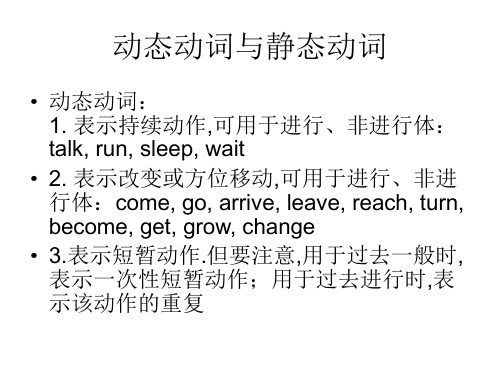
这类动词有hear, learn, tell, say, gather 等: I hear that a big shot is coming to our university.
• She tells me you’re entering for the competition / examination. • 历史现在时:p. 127
• It was the first / the second time that he had turned on his father.
动词:宾语的种类
• A. beat the drum / a boy; beat a retreat / beat time / beat the record / beat one’s brains.
一般过去时
• 1. 表示过去一次性或习惯性动作:p. 128 • 2. 表示现在和将来: • 1want, hope, think , wonder等几个动词用于过去
时可表示委婉语气:I wondered if you could spare me a few minutes. / I hoped you could come here. Suppose we lunched on porridge made with lean meat and preserved egg? • 2> 用于某些固定结构中:I wish the Campus were not so far away from GZ. / It’s high time that you went to bed. / If only I had enough money now./ He looks as if he was ill. / He treats the children as if they were his own.
《动态和静态动词》课件
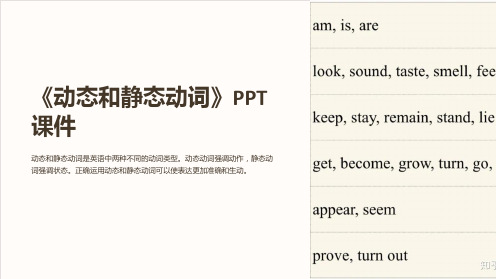
2 强调状态
静态动词强调状态。
例子
1 He runs every day.
他每天都跑步。
2 He is tired today.
他今天很累。
总结
1 动态动词和静态动词是英语中两种不同的动词类型。 2 动态动词强调动作,静态动词强调状态。 3 运用动态和静态动词能使表达更准确生动。
《动态和静态动词》PPT 课件
动态和静态动词是英语中两种不同的动词类型。动态动词强调动作,静态动 词强调状态。正确运用动态和静态动词可以使表达更加准确和生动。
什么是动态动词?
1 描述动作或事件
动态动词描述一个动作或 者事件。
2 具有时态功能
3 例子
可以用来构成一般现在时、 一般过去时、一般将来时 等时态。
run(跑)、eat(吃) 、play(玩)、dance( 跳舞)等
什么是静态动词?
1 描述状态、性质、感 2 不具有时态功能
3 例子
觉等
只有一般现在时和一般过
be(是)、seem(似乎
静态动词描述状态、性质、去时两种。)、appear(出现)、
感觉等。
feel(感觉)等
动态和静态动词的区别
1 强调动作
动态动词和静态动词daynamic and stative verbs
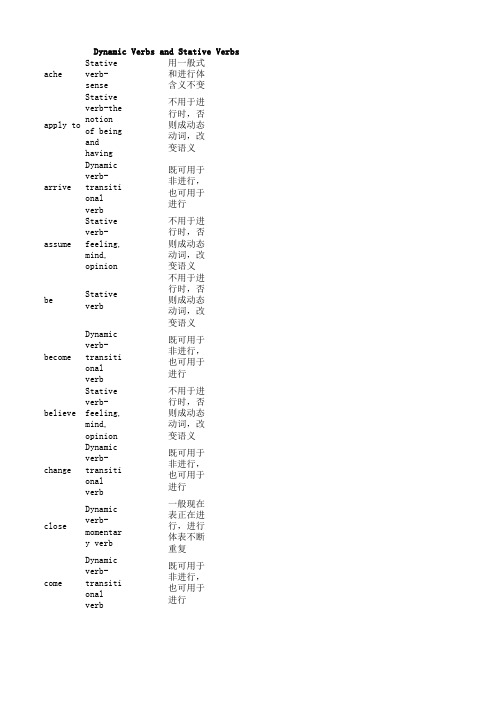
Dynamic Verbs and Stative Verbsache Stative verb-sense用一般式和进行体含义不变apply to Stative verb-the not不用于进行时,否则成动态动词,改变语义arrive Dynamic verb-transit既可用于非进行,也可用于进行assume Stative verb-feeling不用于进行时,否则成动态动词,改变语义be Stative verb不用于进行时,否则成动态动词,改变语义become Dynamic verb-transit既可用于非进行,也可用于进行believe Stative verb-feeling不用于进行时,否则成动态动词,改变语义change Dynamic verb-transit既可用于非进行,也可用于进行close Dynamic verb-momenta一般现在表正在进行,进行体表不断重复come Dynamic verb-transit既可用于非进行,也可用于进行consider Stative verb-feeling不用于进行时,否则成动态动词,改变语义cost Stative verb-the not不用于进行时,否则成动态动词,改变语义detest Stative verb-feeling不用于进行时,否则成动态动词,改变语义differ from Stative verb-the not不用于进行时,否则成动态动词,改变语义drink Dynamic verb-durativ既可用于非进行,也可用于进行eat Dynamic verb-durativ既可用于非进行,也可用于进行fear Stative verb-feeling不用于进行时,否则成动态动词,改变语义feel Stative verb-sense用一般式和进行体含义不变fit Stative verb-the not不用于进行时,否则成动态动词,改变语义fly Dynamic verb-durativ既可用于非进行,也可用于进行get Dynamic verb-transit既可用于非进行,也可用于进行go Dynamic verb-transit既可用于非进行,也可用于进行grow Dynamic verb-transit既可用于非进行,也可用于进行hate Stative verb-feeling不用于进行时,否则成动态动词,改变语义have Stative verb不用于进行时,否则成动态动词,改变语义hear Stative verb-sense不用于进行时,否则成动态动词,改变语义hit Dynamic verb-momenta一般现在表正在进行,进行体表不断重复hold Stative verb-the not不用于进行时,否则成动态动词,改变语义hurt Stative verb-sense用一般式和进行体含义不变imagine Stative verb-feeling不用于进行时,否则成动态动词,改变语义jump Dynamic verb-momenta一般现在表正在进行,进行体表不断重复kick Dynamic verb-momenta一般现在表正在进行,进行体表不断重复knock Dynamic verb-momenta一般现在表正在进行,进行体表不断重复know Stative verb-feeling不用于进行时,否则成动态动词,改变语义lack Stative verb-the not不用于进行时,否则成动态动词,改变语义lack Stative verb-the not不用于进行时,否则成动态动词,改变语义leave Dynamic verb-transit既可用于非进行,也可用于进行like Stative verb-feeling不用于进行时,否则成动态动词,改变语义love Stative verb-feeling不用于进行时,否则成动态动词,改变语义mean Stative verb-feeling不用于进行时,否则成动态动词,改变语义measure Stative verb-the not不用于进行时,否则成动态动词,改变语义mind Stative verb-feeling不用于进行时,否则成动态动词,改变语义notice Stative verb-feeling不用于进行时,否则成动态动词,改变语义open Dynamic verb-momenta一般现在表正在进行,进行体表不断重复play Dynamic verb-durativ既可用于非进行,也可用于进行prefer Stative verb-feeling不用于进行时,否则成动态动词,改变语义put Dynamic verb-momenta一般现在表正在进行,进行体表不断重复rain Dynamic verb-durativ既可用于非进行,也可用于进行reach Dynamic verb-transit既可用于非进行,也可用于进行read Dynamic verb-durativ既可用于非进行,也可用于进行regret Stative verb-feeling不用于进行时,否则成动态动词,改变语义remember Stative verb-feeling不用于进行时,否则成动态动词,改变语义resemble Stative verb-the not不用于进行时,否则成动态动词,改变语义run Dynamic verb-durativ既可用于非进行,也可用于进行see Stative verb-sense不用于进行时,否则成动态动词,改变语义shut Dynamic verb-momenta一般现在表正在进行,进行体表不断重复sit Dynamic verb-durativ既可用于非进行,也可用于进行sleep Dynamic verb-durativ既可用于非进行,也可用于进行smell Stative verb-sense不用于进行时,否则成动态动词,改变语义stand Dynamic verb-durativ既可用于非进行,也可用于进行suppose Stative verb-feeling不用于进行时,否则成动态动词,改变语义take out Dynamic verb-momenta一般现在表正在进行,进行体表不断重复talk Dynamic verb-durativ既可用于非进行,也可用于进行taste Stative verb-sense不用于进行时,否则成动态动词,改变语义think Stative verb-feeling不用于进行时,否则成动态动词,改变语义think Stative verb-feeling不用于进行时,否则成动态动词,改变语义turn Dynamic verb-transit既可用于非进行,也可用于进行understand S tative verb-feeling不用于进行时,否则成动态动词,改变语义want Stative verb-feeling不用于进行时,否则成动态动词,改变语义watch Dynamic verb-durativ既可用于非进行,也可用于进行weigh Stative verb-the not不用于进行时,否则成动态动词,改变语义wish Stative verb-feeling不用于进行时,否则成动态动词,改变语义work Dynamic verb-durativ既可用于非进行,也可用于进行write Dynamic verb-durativ既可用于非进行,也可用于进行。
动词基础知识
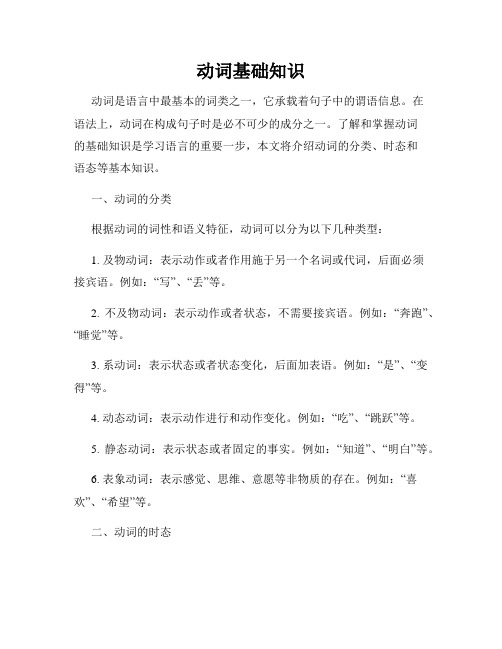
动词基础知识动词是语言中最基本的词类之一,它承载着句子中的谓语信息。
在语法上,动词在构成句子时是必不可少的成分之一。
了解和掌握动词的基础知识是学习语言的重要一步,本文将介绍动词的分类、时态和语态等基本知识。
一、动词的分类根据动词的词性和语义特征,动词可以分为以下几种类型:1. 及物动词:表示动作或者作用施于另一个名词或代词,后面必须接宾语。
例如:“写”、“丢”等。
2. 不及物动词:表示动作或者状态,不需要接宾语。
例如:“奔跑”、“睡觉”等。
3. 系动词:表示状态或者状态变化,后面加表语。
例如:“是”、“变得”等。
4. 动态动词:表示动作进行和动作变化。
例如:“吃”、“跳跃”等。
5. 静态动词:表示状态或者固定的事实。
例如:“知道”、“明白”等。
6. 表象动词:表示感觉、思维、意愿等非物质的存在。
例如:“喜欢”、“希望”等。
二、动词的时态动词的时态表示动作或状态所处的时间。
英语中常见的时态有以下几种:1. 现在时:表示目前正在进行或者经常性发生的动作。
例如:“I eat an apple every day.”(我每天吃一个苹果。
)2. 过去时:表示过去发生的动作或者状态,通常和具体的时间状语连用。
例如:“She watched a movie last night.”(她昨晚看了一场电影。
)3. 将来时:表示将来要发生的动作或者状态,通常和表示将来的时间状语连用。
例如:“They will go to the beach tomorrow.”(他们明天要去海滩。
)4. 进行时:表示正在进行的动作或者状态。
例如:“He is reading a book now.”(他正在看书。
)5. 完成时:表示动作在过去某个时间点已经完成。
例如:“We have finished our homework.”(我们已经完成了作业。
)三、动词的语态动词的语态表示动作的发生者和承受者之间的关系。
常见的动词语态有以下两种:1. 主动语态:表示动作的发出者是主语。
- 1、下载文档前请自行甄别文档内容的完整性,平台不提供额外的编辑、内容补充、找答案等附加服务。
- 2、"仅部分预览"的文档,不可在线预览部分如存在完整性等问题,可反馈申请退款(可完整预览的文档不适用该条件!)。
- 3、如文档侵犯您的权益,请联系客服反馈,我们会尽快为您处理(人工客服工作时间:9:00-18:30)。
静态动词与动态动词
动词按其词汇意义可分为动态动词(Dynamic Verb)和静态动词(Static Verb)。
1)动态动词表示一种运动状态,绝大多数动词是动态动词。
动态动词既可用于进行体,也可用于非进行体。
动态动词大体分为三类:
a)表示持续动作的动词:drink,eat,read,write,walk,run,play,talk,fly,watch 等。
b)表示短暂动作的动词:leave,go,come,see,arise,break,open,meet,close,join,jump,admit,discover等。
c)表示位移或状态改变的动词:become,turn,grow,change,come,
go等。
例 1 He is writing a letter to his friend.
他正在给朋友写信。
例 2 He closed the windows.
他关上了窗子。
例 3 The leaves on the tress are turning green.
树叶正在转绿。
例 4 He changed his mind.
他改变了想法。
2)静态动词表示一种相对静止的动词,常用于非进行体,也可归纳为三类:
a)表示各种关系的动词:如contain,belong,consist of,have,concern,owe,involve,resemble,differ,exist,hold,cost,fit,lack,matter,compare,deserve,measure,weigh等。
b)表示感觉感知的动词:如feel,see,taste,smell,hear等。
c)表示心理状态的动词:如think,believe,know,consider,hope,want,mean,forget,remember,expect,understand,leave,hate,regret,envy,admire,suppose,fear,care等。
例 1 The hall can contain 1,000 people.
大厅可以容纳1000人。
例 2 The report consists of five parts.
这个报告包括五部分。
例 3 The camera cost ¥200.
这架照相机值200元。
例 4 The little girl saw a black dog beside the door.
小女孩看见门边有只黑狗。
例 5 He hates being pushed around.
他讨厌任人摆布。
